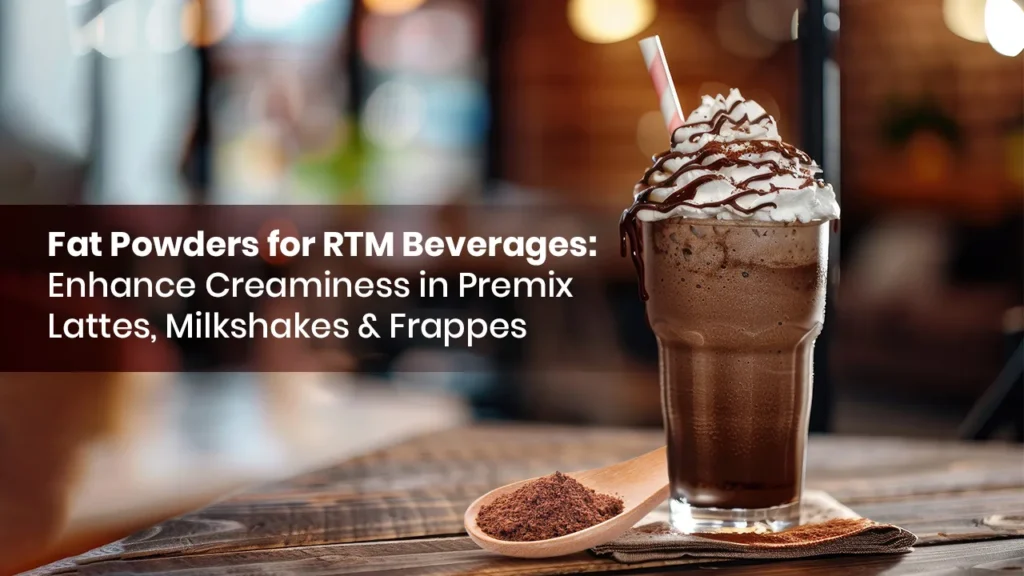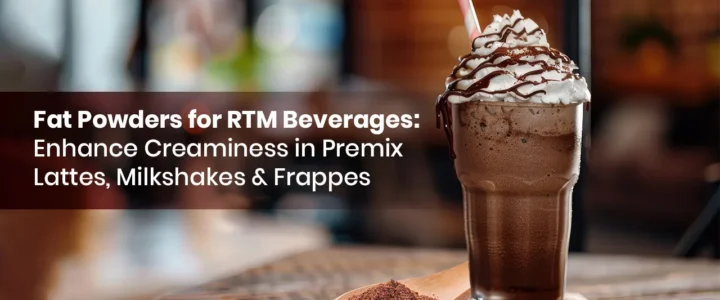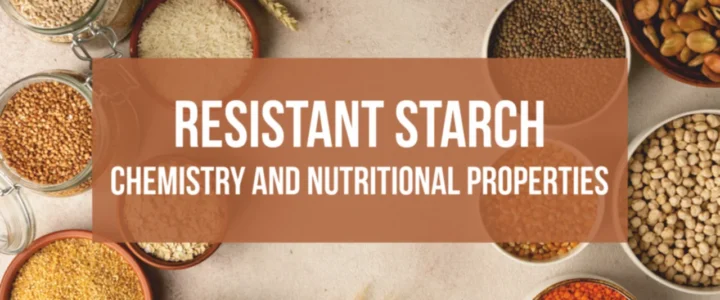Fat Powders for RTM Beverages: Enhance Creaminess in Premix Lattes, Milkshakes & Frappes

Ready-to-mix (RTM) drinks have revolutionized the way people consume their go-to café-style treats. From cold lattes and frappes to thick milkshakes and protein drinks, the types of beverages that consumers can enjoy with ease and convenience are endless. At the hub of this extravagance is a subtle yet integral ingredient that maximizes both flavor and texture: fat powders.
As a trusted fat powder supplier for beverage premixes, Vinayak Ingredients ensures consistent quality and performance for your RTM applications.
Fat powders are dry-form ingredients that introduce the richness and smoothness of fats into powdered beverage premixes, yet with enhanced stability and convenience over traditional oils or dairy creamers. They assist in providing the mouthfeel and body that make reconstituted beverages feel truly rewarding.
Why Fat Powdersin Premix Beverages
Some of the main challenges in creating RTM drinks are delivering a creamy, balanced mouthfeel without requiring refrigeration or fresh dairy. Fat powders bridge this divide. They add a smooth, silky texture to beverages once reconstituted with water or milk, enhancing drinkability and backing up flavor intensity.
Whether it’s the velvety texture of an ice-cold latte, the rich body of a milkshake premix, or the well-balanced creaminess of a powdered protein drink, fat powders play a vital role in completing the beverage experience.
Fat Powders We Provide: Plant-Based Creaminess, Naturally
At Vinayak Ingredients, a reliable fat powder supplier for beverages, we offer a diverse portfolio of plant-based fat powders specifically formulated to meet the various needs of RTM beverage systems. Our range includes:
● Sunflower Fat Powder contains a clean, neutral taste that enhances beverages without dominating them. It’s perfect for coffee premixes and flavored lattes where subtlety and texture are key.
● Groundnut Fat Powder contributes a nutty warmth and rich mouthfeel. It blends seamlessly into chocolate, malt, or caramel-flavored mixes, offering depth and indulgence.
● Coconut Fat Powder provides a soft sweetness and silky finish, ideal for tropical-themed premix drinks, vegan milkshakes, and exotic frappes.
● MCT Fat Powder offers a light, rounded creaminess with a neutral flavor and is well-suited for functional mixes like keto-friendly RTM coffees or performance nutrition shakers.
● HOSO (High Oleic Sunflower Oil) Fat Powder provides a neutral flavor with light smoothness, ideal for clean-label premix beverages requiring high oxidative stability.
● Soybean Fat Powder delivers balanced creaminess with a hint of natural bean-like flavor, making it ideal for plant-protein premixes, soy lattes, and dairy alternatives.
Promoting Stability and Shelf Life in Powdered Beverages
Beyond flavor and texture, fat powders provide functional benefits that support large-scale manufacturing of powdered drink premixes. Their dry state contributes to a longer shelf life, making them ideal for mass distribution and ambient storage.
They dissolve easily upon mixing and remain stable in various reconstitution conditions, ensuring the final beverage looks visually appealing and retains its creaminess over time.
These powders offer formulation versatility, succeeding in dairy-based mixes, plant-based systems, and functional beverage blends. Whether the goal is indulgence, health, or a combination of both, fat powders adapt seamlessly to different premix formats.
As a specialized fat powder supplier for beverages, we help brands meet texture and stability goals with tailor-made fat powder solutions that support ease of reconstitution and sensory excellence.
Making a Lasting Beverage Experience
Today’s consumers expect more than just taste from their drink mixes—they seek texture, consistency, and that unmistakable creamy sensation that mimics fresh-made beverages. Fat powders enhance the experience in an understated yet powerful way. They smoothen flavor edges, round off taste profiles, and elevate the overall quality perception.
Each sip of a reconstituted frappe or the silky mouthfeel of a protein latte owes much of its appeal to the thoughtful use of premium fat powders. Though subtle in presence, their impact is clearly felt in every sip.
In Conclusion
In the evolving world of ready-to-mix beverages, creating consistently indulgent, stable, and easy-to-use products is key. With sunflower, groundnut, coconut, MCT, and other plant-derived fat powders, beverage formulators can craft mixes that deliver on richness, convenience, and sensory appeal, without compromise.
From instant lattes and powdered frappes to thick milkshake blends and fitness shakes, fat powders offer a custom approach to creating creamy, craveable drinks with shelf stability and ease of preparation.
Vinayak Ingredients is your trusted fat powder supplier for beverages, offering innovative, plant-based fat powder solutions designed to elevate the quality of every premix product.










